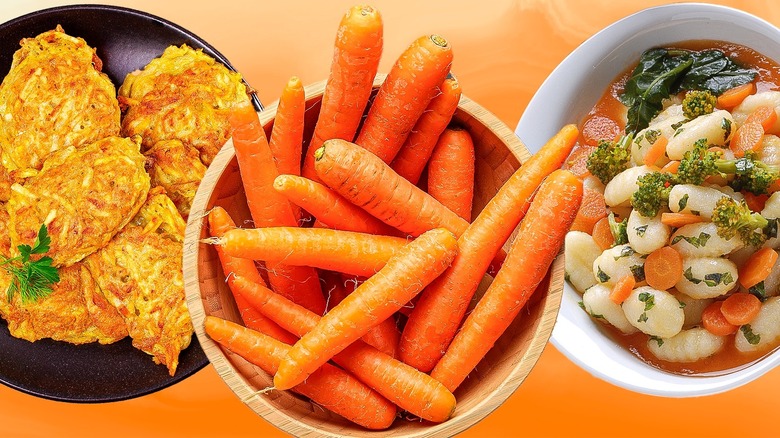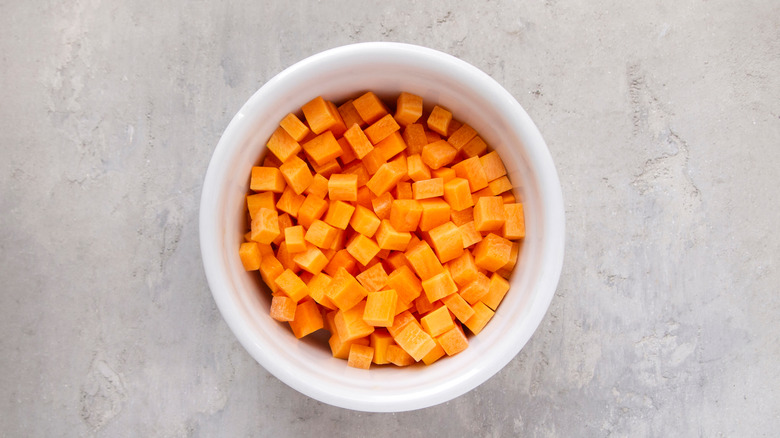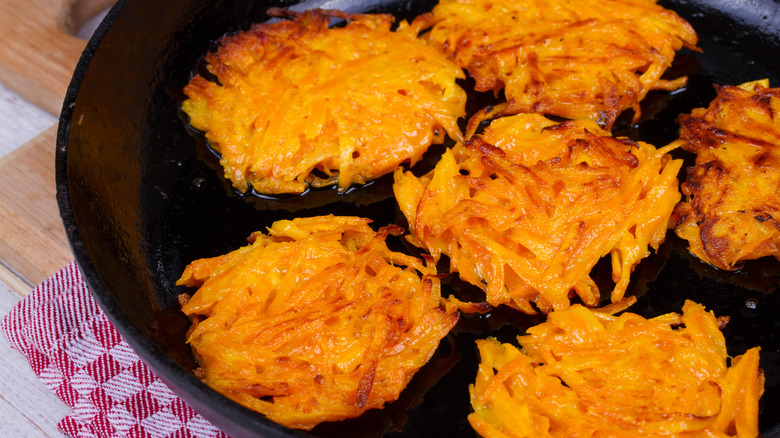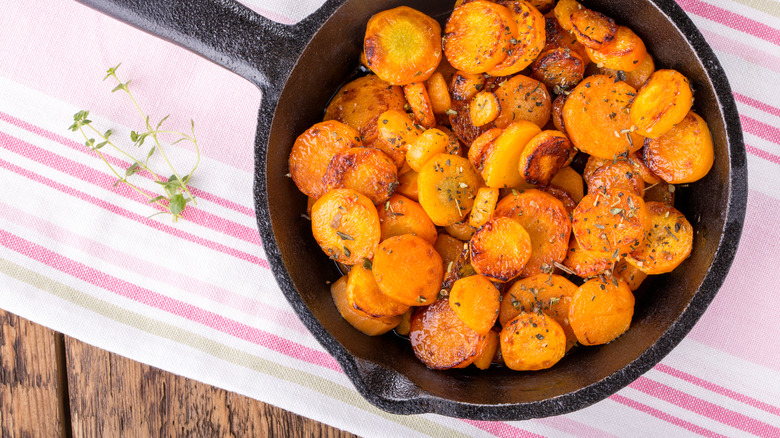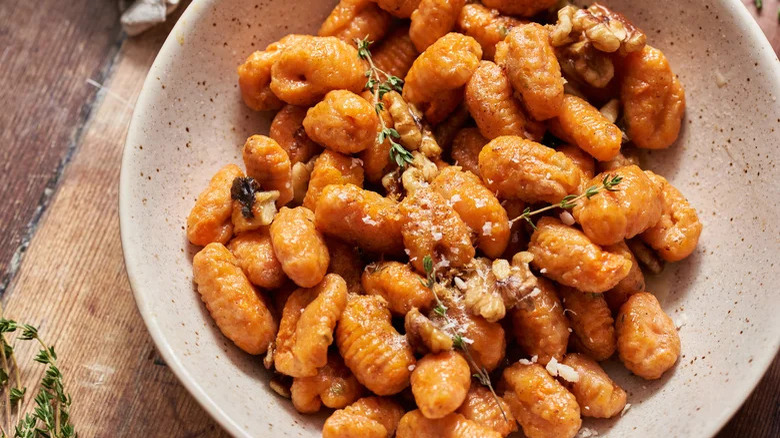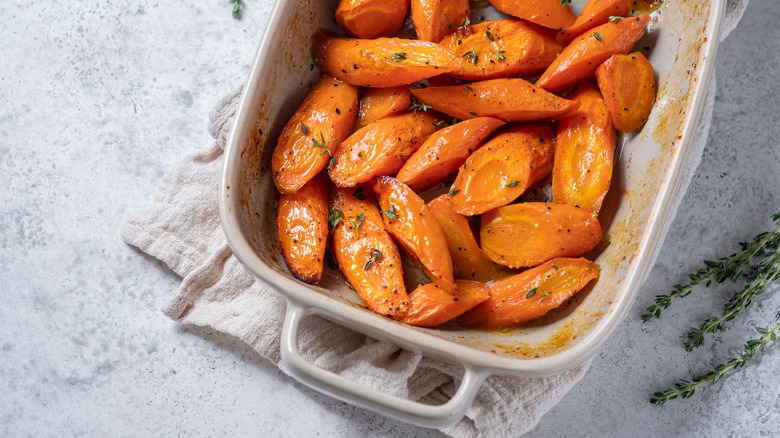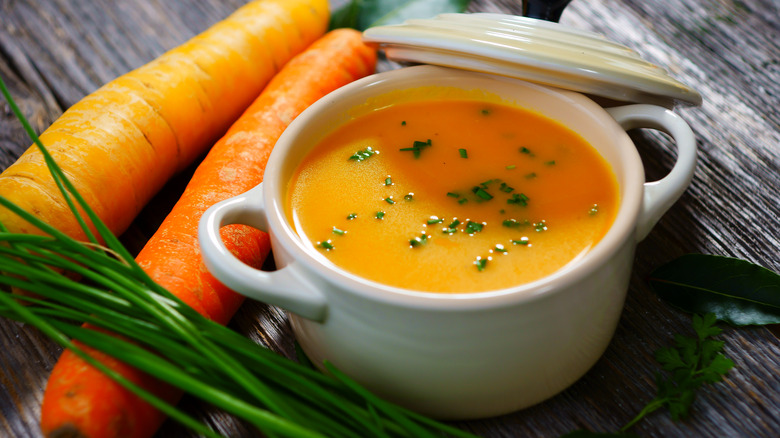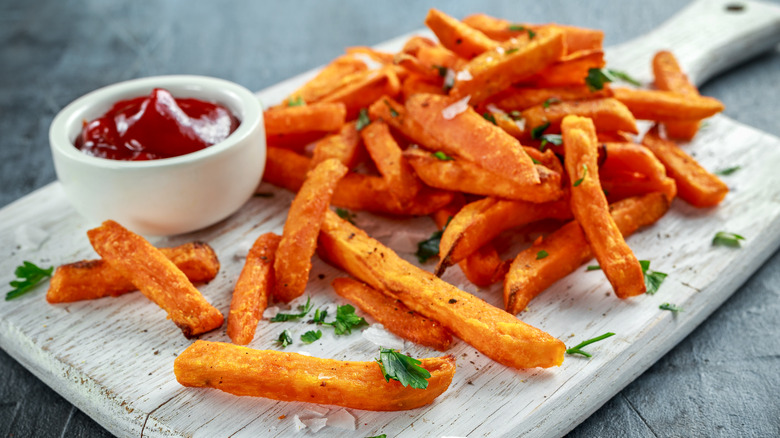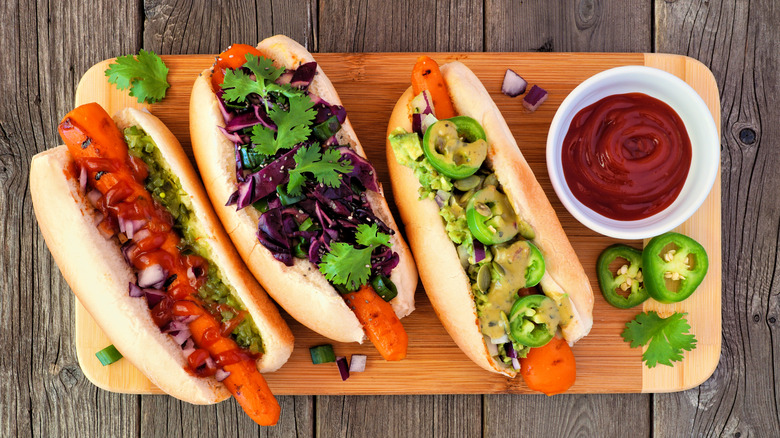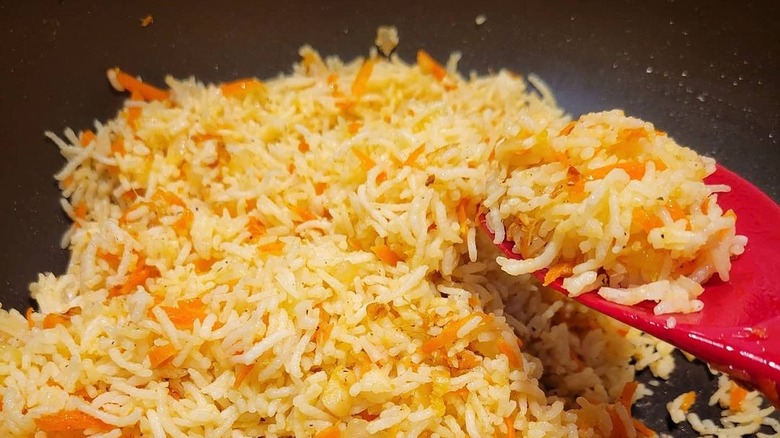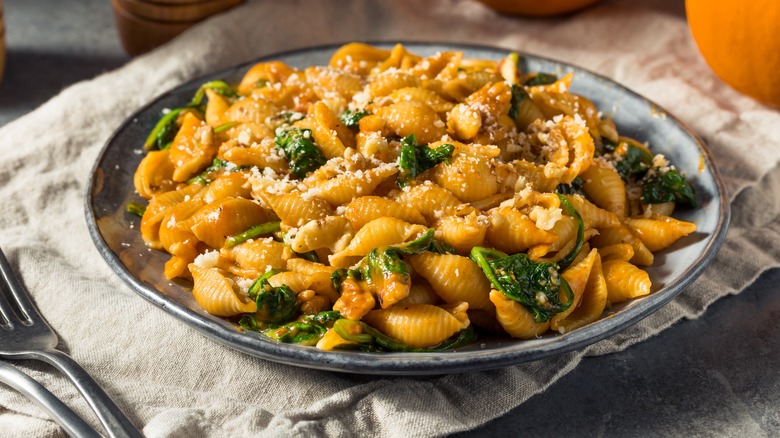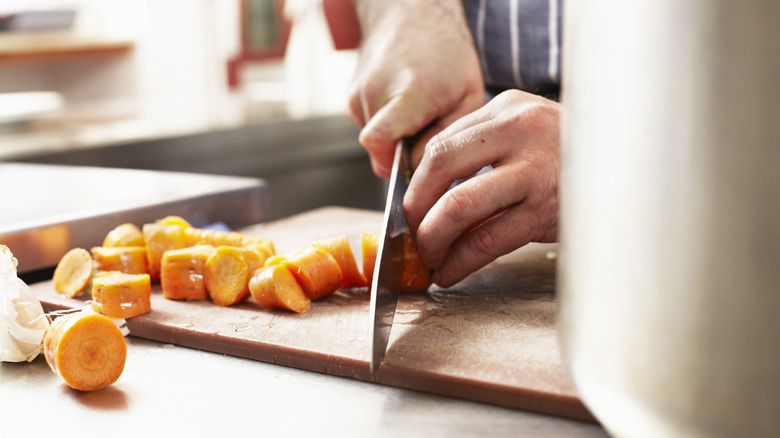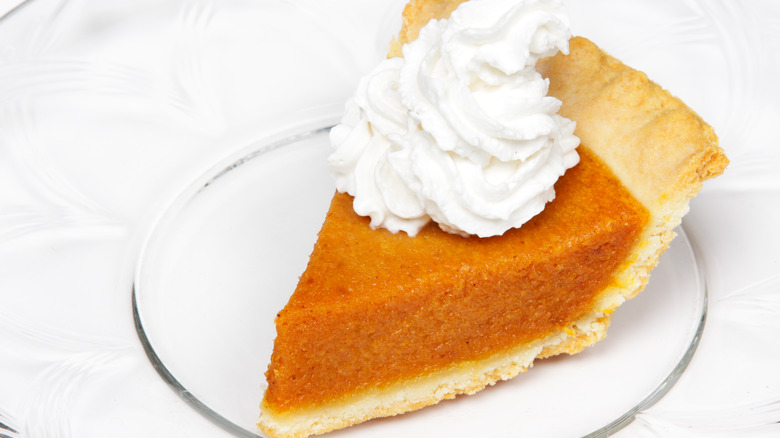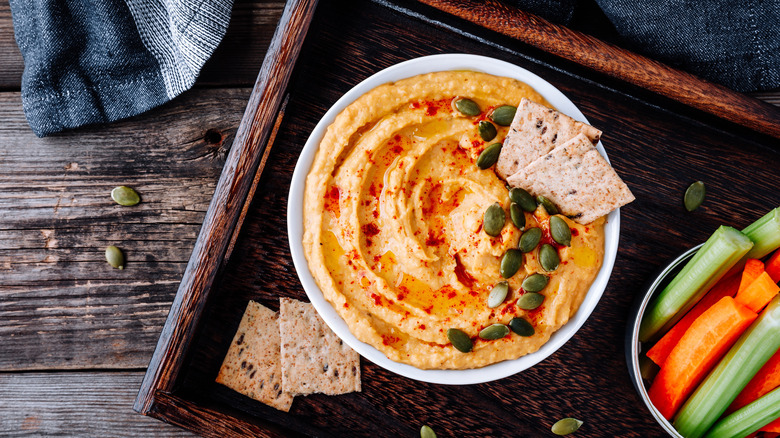14 Carrot Hacks For Elevating The Veggie Favorite
Between their sweet flavor and delicious versatility, carrots are staple vegetables in the kitchen. They're a basic ingredient in myriad recipes, from soups to stews and side dishes to desserts. However, as carrots are so common and easy to find, preparing them can easily become boring. With these unique methods in your repertoire, you can expand your carrot cooking skills and enjoy the root vegetable in new ways.
After all, when you consider the impressive nutrient content of carrots, you'll likely want to increase your intake of the vegetable. They're high in fiber, an essential nutrient needed for healthy digestion and blood cholesterol. Carrots also contain vitamin A, which is needed for good eyesight, and potassium, which naturally controls blood pressure. Needless to say, carrots are some of the healthiest foods you can eat, and these tips for preparing them will make it easy to eat more of them.
For best results, always use the freshest carrots you can find. At the grocery store, look for ones that are firm, deep orange, and free of soft and mushy spots. Don't worry if the carrots have dirt on them, as they can be scrubbed and washed right off. It's recommended to choose smaller carrots over large ones, as the latter will contain too much starch and water, rendering them less flavorful. Smaller carrots will be sweeter, and therefore, provide the optimal flavor for these carrot cooking techniques.
Microwave carrots
When it comes to cooking hacks, the microwave is a useful tool — and heating carrots is no exception. Cooking the vegetable in the microwave will quickly steam it, allowing you to skip the pot or save space on the stovetop. Simply peel and cut raw carrots, place them in a microwave-safe bowl with water, then heat in the microwave for a few minutes. You can then pierce the carrots with a fork to check their doneness. If they're still too tough for your liking, reheat the carrots for one more minute.
Note that microwaving carrots won't draw out their natural sweetness like sautéing or roasting does. This means the vegetable will lack flavor unless you add butter and spices. Even then, it won't be a mouthwatering side dish on its own, so consider saving this technique when you need to blend carrots into another recipe. For example, if you plan to make mashed carrots or puree carrots into a sauce, smoothie, or soup, microwaving the root vegetable will come in handy.
Make carrot latkes
If you love potatoes, you've likely had your fair share of latkes, a staple dish found in Ashkenazi Jewish cuisine. The potato pancakes — which are traditionally enjoyed during Hanukkah — are deliciously simple, as they're made of nothing more than grated potatoes, onion, salt, and a binder such as matzo meal or egg. But you're not limited to the classic potato; you can make latkes with any vegetable that you can grate, including carrots.
To turn carrots into crispy latkes, simply follow your favorite potato latke recipe and replace the grated potatoes with carrots. You could even mix and match carrots with different vegetables, including parsnips and beets, which is a handy trick for using up leftover produce. Once you've fried the carrot fritters, serve them with your go-to latke toppings. Applesauce and sour cream are traditional options, but you can switch it up with a poached egg, whipped cream cheese, guacamole, or Greek yogurt and a drizzle of honey.
Roast them in a skillet
When roasted in the oven, carrots develop a mouthwatering crispy and browned crust. The method also highlights their sweet and earthy flavors, making it a popular technique among carrot enthusiasts. However, you don't necessarily need to use the oven to roast carrots, as it's possible to achieve the same texture and flavor in a skillet on a stovetop. This method is ideal if you'd like to use the oven for another dish or if you want to avoid heating up your kitchen during the hotter months. Plus, oven-roasting carrots can take a long time, about 30 to 40 minutes, depending on how you cut the vegetables.
The trick is to cut the carrots crosswise and lengthwise. This will expose more surface area to the heat, allowing the vegetable to become sufficiently seared. From there, cook the carrots in a skillet with oil or butter, along with your go-to seasonings. Flip and rotate them occasionally to ensure they are heated evenly; the skillet-roasted carrots will be ready in just six minutes.
Upgrade homemade gnocchi
For a unique way to cook carrots, use them in place of potatoes when making homemade gnocchi. The vegetable will give the gnocchi a sweet flavor that you simply can't get with regular potatoes. What's more, the fluffy carrot gnocchi pieces will have a beautiful orange hue, making the dish perfect for seasonal fall recipes.
If texture is a priority for you, be sure to peel the carrots before boiling them. This is especially important if your carrots have tiny "hairs," which are actually small roots. Otherwise, you can skip the peeling if you're pressed for time and aren't bothered by varying textures. From there, chop and boil the carrots until soft, then mash and combine with flour. After kneading and chopping the dough into small pillows, boil the gnocchi as usual and serve with your favorite sauce. To accentuate the fall-inspired flavors of the carrots, go for a condiment like browned butter, tahini dressing, or maple syrup vinaigrette.
Add a honey butter glaze
One of the simplest ways to elevate carrots is to cook them in a honey butter glaze. Not only does this trick take just minutes to do, but it's a simple technique that requires zero fancy skills or ingredients. As the name suggests, honey butter glaze requires nothing more than honey and butter, which you likely already have in your kitchen. All you need to do is heat butter in a pot on the stovetop, then mix in honey until the ingredients are fully combined. Place your peeled and chopped carrots on a lined baking sheet, drizzle the glaze over the vegetables, then roast for about 30 minutes. The honey will caramelize the carrots, while the butter will add flavor and help the carrots cook to golden perfection.
The best part is that you can easily customize the glaze based on your preferences or what you have on hand. For example, if you don't have honey, go for maple syrup instead. It will add a robust, almost nutty flavor that pairs so well with cooked carrots. Maple syrup is also a viable option if you don't eat animal products and want to avoid honey. In this case, feel free to use a plant-based butter made of olive oil instead of traditional butter.
Blend carrots into soup
Thanks to their impressive nutrient content, carrots are one of the most nutritious foods you can eat. But if you're not feeling inspired by carrot side dishes or entrées, try blending the root vegetable into soup. The key is to cook them first, which will make them sweeter and softer. Boiling and steaming are the simplest techniques, but if you're craving a deeper flavor profile, grill or roast the carrots first.
When blended into soups, cooked carrots will add a creamy texture and earthy sweetness that pairs well with other cold-season produce. Examples include butternut squash, potatoes, beets, and broccoli, though you're not limited to vegetables. Case in point: In our silky carrot apple soup recipe, boiled carrots are blended with apples for a sweet and flavorful soup.
Using an immersion blender will let you puree the carrots and other ingredients right in the pot. However, if you'd like to use a traditional blender, be sure to let everything cool first. Otherwise, the steam from the ingredients will increase the pressure in the blender, causing the top to fly off and creating a mess. It's also a good idea to remove the plug, or the stopper in the lid, then cover the opening with a towel to let steam escape.
Use them for fries
If you haven't tried cooking carrots as fries, you're in for a treat. The vegetable is an excellent substitute for potatoes, as it develops a similar crispy exterior and creamy interior when baked in the oven. Start by slicing the carrots into wedges or thin strips, then tossing them with oil and spices like salt, black pepper, and dried parsley. Bake the carrots in an oven set to 400 F to 425 F; this temperature will ensure they develop that perfectly crispy fry-like texture.
A trick to making extra-crispy carrot fries is to coat the carrots in cornstarch or arrowroot powder after tossing them in oil. As the fries bake, the powder will absorb excess moisture, helping the carrots crisp up. If you're unfamiliar with arrowroot powder, it's typically sold in the baking section near the cornstarch and flour. It's also usually more expensive than cornstarch, though it does contain a bit more fiber if that's important to you.
Grill carrot hot dogs
No barbecue, picnic, or summer soirée is complete without the classic hot dog. But if you're trying to cut back on processed meat or hosting guests who prefer meatless dishes, you may be looking for alternatives. Store-bought plant-based hot dogs are a popular choice, but they can be pricey, especially if you're feeding a crowd. Luckily, you can cook carrots so they taste like hot dogs, and it's surprisingly easy to do.
The trick to making carrot hot dogs is to marinate peeled raw carrots in umami ingredients, such as liquid smoke and soy sauce. The liquid smoke is particularly helpful for mimicking the flavor of hot dogs, as it provides smoky barbecue notes. Ingredients like garlic, smoked paprika, and apple cider vinegar will emphasize the savory meat-like elements even more. Once marinated, the carrots can be tossed on the grill and cooked until charred, then served on buns with your go-to hot dog toppings.
Cook carrot rice
If you often make fried rice with carrots, you will want to try cooking carrot rice. The exact ingredients vary by recipe, but typically, it is made of basmati rice flavored with grated carrots, tomato or tomato paste, onion, and warm spices like turmeric, cinnamon, and cardamom. Some versions use finely diced carrots for a delightful contrast of textures, but grated carrots cook more quickly.
Basmati rice is exceptionally fluffy, making it a stellar candidate for this dish. The secret to achieving the best texture is to soak the grains in cold water before cooking them; this will allow the rice to sufficiently plump up and cook evenly. It's also a good idea to leave the rice undisturbed for 10 to 15 minutes after you turn off the heat. During this time, the steam will continue to gently cook the rice, paving the way for fluffier grains.
Turn carrots into pasta sauce
Another clever way to use carrots is to make them into pasta sauce. The method is similar to making creamy carrot soup, as it involves cooking the vegetable and pureeing it in the blender. For the best flavor, cook the carrots via grilling, roasting, or sautéing, as these methods will add a satisfying depth of flavor. Boiling, microwaving, and steaming the carrots also work just fine, so long as you add plenty of flavorful ingredients to the sauce.
Once the carrots are tender, puree them with a bit of broth, salt, pepper, onions, garlic, and miso paste for a punch of umami flavor. You'll also need broth and cream to give the sauce a smooth and pourable consistency, though you can swap the cream for canned coconut milk or soaked cashews to make it dairy-free. Enjoy the finished sauce with your favorite pasta, along with roasted vegetables and a protein of your choice.
Make carrot bacon
When it comes to bacon substitutes, carrots might not come to mind — but they're surprisingly excellent candidates. It's all thanks to Tabitha Brown, who first shared carrot bacon on TikTok in 2020. The dish went viral, and since then, carrots have become a staple in the world of plant-based bacon recipes.
To prepare carrots so they taste like bacon, start by peeling raw carrots, then running the vegetable peeler across the length of each carrot. This will create thin, long strips that look like ribbons. Next, you'll want to add the carrot strips to a marinade made of olive or avocado oil, maple syrup, liquid smoke, soy sauce, or tamari, plus seasonings like garlic powder, onion powder, and smoked paprika. The longer you marinate the carrots, the better flavor they'll have, so aim to let them soak for at least 30 minutes or even a few hours.
You can then cook the carrots in an air fryer or oven; the latter will let you cook more bacon strips at once. Regardless of the method you choose, keep a close watch on the carrot bacon as it cooks quickly.
Overly acidic dishes will benefit from carrots
As it turns out, carrots don't have to be a main ingredient for them to shine in recipes. They can be used to fix common cooking mistakes, as proven by this clever hack: The next time you're making soup, sauce, or stew and it tastes too acidic, add carrots to the mix. The sweetness of the vegetable will naturally reduce the tanginess — which can happen if you accidentally overdo acidic ingredients like tomato paste or vinegar — resulting in a more balanced flavor profile.
The best part is that you can incorporate carrots in several ways, depending on your preference and the nature of the dish. For example, when grated, carrots can effortlessly blend in without drastically changing the texture. Meanwhile, chopped or diced carrots will add texture, which may be preferable for chunkier preparations like stews or chilis. You could even add whole peeled carrots and remove them from the dish before serving.
Bake carrots into pie
For a tasty riff on the iconic pumpkin pie, take a tip from television chef and author Nadiya Hussain and use pureed carrots instead of canned pumpkin. Not only is the switch surprisingly delicious, but it's also useful if you have a lot of carrots on hand. To use the root vegetable as a pie filling, Hussain stews the carrots in water and vanilla seeds and purees them until smooth. The finished puree can then be used just like canned pumpkin in your favorite pumpkin pie recipe.
It's worth noting that the carrot version will taste significantly sweeter, so consider adjusting the other sweeteners in the recipe. Another option is to replace just half of the canned pumpkin listed in the recipe with pureed carrots. In either case, using the same spices found in pumpkin pie — think cinnamon, nutmeg, ginger, and allspices — will ensure the finished pie has the same warm and cozy flavor.
Carrots work great in hummus
If homemade hummus is a staple in your home, consider adding cooked carrots to your next batch. The ingredient will add an earthy sweetness to the dip, which can help tone down the nuttiness of chickpeas. This is especially true if you roast or sauté the carrots first, as these cooking methods will caramelize and concentrate the sugars naturally found in the carrots. Furthermore, as with other blended carrot recipes, adding carrots to hummus will make it extra creamy and satisfying.
Carrot hummus can be served just like the regular kind. Enjoy it with warm pita bread, rice cakes, or sandwiches, where it can help moisten dry bread. As a dip, carrot hummus is delectable with crackers, chips, or sliced vegetables like broccoli, red bell peppers, and yes — more carrots. When you're just about to finish the rest of your hummus, mix it with warm pasta water for an instant creamy pasta sauce.
